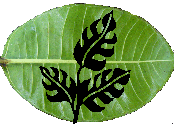

History of Vanilla:
Hundreds of years ago in the
tropical forests of the Aztec kingdom, an ancient people discovered the
fruit of a delicate orchid—and a flavor they called vanilla. The
Totonaco people of the Vera Cruz region in Mexico were the first to cultivate
the divine vanilla crop. They believed the sweet vanilla nectar to be
a gift from the gods with a mythology of a pair of fallen lovers whose
sacred blood marked the spot where a vigorous vine and a beautiful flower
grew to fill the air with the aroma of true love and beauty.
The Aztec monarch, Itzcoatl,
conquered the Totonacos in 1427 and immediately came to love the flavor
and aroma of the Totonaco’s vanilla. The Aztecs called the prized
spice “tlilxochitl “black flower”. They used it to flavor
their famous chocolate drink, cacahuatl (chocolate water), made from cocoa
beans, ground corn, ground vanilla beans, and honey. The Aztecs required
that the Totonaco people grow vanilla as a tribute to the Aztec king,
Montezuma.
 When
Hernán Cortés came to Mexico from Spain, in 1519, he traveled
through Vera Cruz where he became intrigued by vanilla. When Cortés
and his men arrived in Mexico City, they were graciously greeted by Montezuma
who thought Cortés was “Quetzalcóatl” a fair skinned
god. Moctezuma served Cortés chocolatll in a golden goblet. Impressed
with Moctezuma’s gold and riches, Cortés and his men later
conspired to kill the Aztec king, hoping to find more treasures hidden
in Montezuma’s palace. Imagine the Spaniards’ disappointment
when, instead of chests full of gold, they found bags of cocoa beans.
When
Hernán Cortés came to Mexico from Spain, in 1519, he traveled
through Vera Cruz where he became intrigued by vanilla. When Cortés
and his men arrived in Mexico City, they were graciously greeted by Montezuma
who thought Cortés was “Quetzalcóatl” a fair skinned
god. Moctezuma served Cortés chocolatll in a golden goblet. Impressed
with Moctezuma’s gold and riches, Cortés and his men later
conspired to kill the Aztec king, hoping to find more treasures hidden
in Montezuma’s palace. Imagine the Spaniards’ disappointment
when, instead of chests full of gold, they found bags of cocoa beans.
The Spaniards
named their exotic spice “vainilla” meaning “little scabbard”
and took it back with them to Spain. Vanilla slowly became popular throughout
all of Europe. The French took a particular liking to the flavor and began
using it as an ingredient in pastries, cakes and beverages.
The French wanted to grow vanilla
for themselves in their colonies where the climate was similar to that
of Vera Cruz. They were able to grow healthy plants that blossomed, but
were never able to get a bean from the plant. When the Totonaco’s
got wind of this, they laughed, and called it the “curse of Moctezuma”.
 For
300 years Mexico maintained its monopoly of vanillabean production despite
constant efforts of theEuropeans to induce vanilla vines to bear beans
elsewhere in the world. It wasn’t until 1836 when Charles Morren,
a French botanist, finally discovered the secret of growing vanilla. His
careful examination of the anatomy of the bean led to his discovery of
the difficulty of pollination. He then performed the pollination by hand.
Thus beans were produced outside of Mexico. Knowledge of theartificial
pollination spread to European nations who had colonized tropical regions
with climates suitable for growing orchids. These areas began planting
vanilla especially the French on the Island of Bourbon (Reunion) and the
Dutch in the Dutch East Indies (Indonesia).
For
300 years Mexico maintained its monopoly of vanillabean production despite
constant efforts of theEuropeans to induce vanilla vines to bear beans
elsewhere in the world. It wasn’t until 1836 when Charles Morren,
a French botanist, finally discovered the secret of growing vanilla. His
careful examination of the anatomy of the bean led to his discovery of
the difficulty of pollination. He then performed the pollination by hand.
Thus beans were produced outside of Mexico. Knowledge of theartificial
pollination spread to European nations who had colonized tropical regions
with climates suitable for growing orchids. These areas began planting
vanilla especially the French on the Island of Bourbon (Reunion) and the
Dutch in the Dutch East Indies (Indonesia).
Today, vanilla is grown comercially mainly
in Madagascar and Indonesia with some production in Mexico, Tonga, French
Polynesia, Fiji, Costa Rica, Uganda, India and China.



|